Together with the four species of echidna, it is one of the five extant species of monotremes, the only mammals that lay eggs instead of giving birth to live young. Like other monotremes it senses prey through electrolocation. It is one of the few species of venomous mammals, as the male platypus has a spur on the hind foot that delivers a venom capable of causing severe pain to humans.
The unusual appearance of this egg-laying, duck-billed, beaver-tailed, otter-footed mammal baffled European naturalists when they first encountered it, and the first scientists to examine a preserved platypus body (in 1799)[4] judged it a fake, made of several animals sewn together.[5]
The unique features of the platypus make it an important subject in the study of evolutionary biology, and a recognisable and iconic symbol of Australia. It has appeared as a mascot at national events and features on the reverse of the Australian twenty-cent coin, and the platypus is the animal emblem of the state of New South Wales.[6]
Until the early 20th century humans hunted the platypus for its fur, but it is now protected throughout its range. Although captive-breeding programs have had only limited success, and the platypus is vulnerable to the effects of pollution, it is not under any immediate threat.
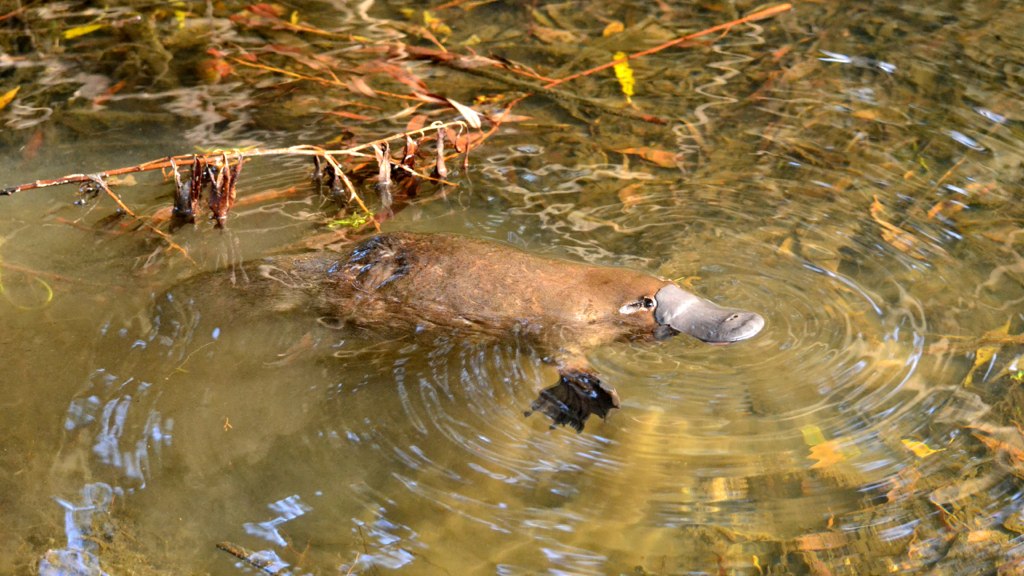
Taxonomy and etymology
Platypus (Ornithorhynchus anatinus) – from the first scientific description in 1799
The common name "platypus" is the latinisation of the Greek word πλατύπους (platupous), "flat-footed",[11] from πλατύς (platus), "broad, wide, flat"[12] and πούς (pous), "foot".[13][14] Shaw assigned the species the Linnaean name Platypus anatinus when he initially described it, but the genus term was quickly discovered to already be in use as the name of the wood-boring ambrosia beetle genus Platypus.[15] It was independently described as Ornithorhynchus paradoxus by Johann Blumenbach in 1800 (from a specimen given to him by Sir Joseph Banks)[16] and following the rules of priority of nomenclature, it was later officially recognised as Ornithorhynchus anatinus.[15] The scientific name Ornithorhynchus anatinus is derived from ορνιθόρυγχος (ornithorhynkhos), which literally means "bird snout" in Greek; and anatinus, which means "duck-like" in Latin.
There is no universally-agreed plural form of "platypus" in the English language. Scientists generally use "platypuses" or simply "platypus". Colloquially, the term "platypi" is also used for the plural, although this is a form of pseudo-Latin;[10] going by the word's Greek roots the plural would be "platypodes". Early British settlers called it by many names, such as "watermole", "duckbill", and "duckmole".[10] The name "platypus" is occasionally prefixed with the adjective "duck-billed" to form "duck-billed platypus".
Description
Platypus in Broken River, Queensland
The body and the broad, flat tail of the platypus are covered with dense, brown fur that traps a layer of insulating air to keep the animal warm.[10][15] The fur is waterproof, and the texture is akin to that of a mole.[18] The platypus uses its tail for storage of fat reserves (an adaptation also found in animals such as the Tasmanian devil[19]). The webbing on the feet is more significant on the front feet and is folded back when walking on land. The elongated snout and lower jaw are covered in soft skin, forming the bill. The nostrils are located on the dorsal surface of the snout, while the eyes and ears are located in a groove set just back from it; this groove is closed when swimming.[15] Platypuses have been heard to emit a low growl when disturbed and a range of other vocalisations have been reported in captive specimens.[10]
A colour print of platypuses from 1863
The platypus has an average body temperature of about 32 °C (90 °F) rather than the 37 °C (99 °F) typical of placental mammals.[21] Research suggests this has been a gradual adaptation to harsh environmental conditions on the part of the small number of surviving monotreme species rather than a historical characteristic of monotremes.[22][23]
Modern platypus young have three teeth in each of the maxillae (one premolar and two molars) and dentaries (three molars), which they lose before or just after leaving the breeding burrow;[15] adults have heavily keratinised pads in their place.[15] The first upper and third lower cheek teeth of platypus nestlings are small, each having one principal cusp, while the other teeth have two main cusps.[24] The platypus jaw is constructed differently from that of other mammals, and the jaw-opening muscle is different.[15] As in all true mammals, the tiny bones that conduct sound in the middle ear are fully incorporated into the skull, rather than lying in the jaw as in cynodonts and other pre mammalian synapsids. However, the external opening of the ear still lies at the base of the jaw.[15] The platypus has extra bones in the shoulder girdle, including an interclavicle, which is not found in other mammals.[15] As in many other aquatic and semiaquatic vertebrates, the bones show osteosclerosis, increasing their density to provide ballast.[25] It has a reptilian gait, with the legs on the sides of the body, rather than underneath.[15] When on land, it engages in knuckle-walking on its front feet, to protect the webbing between the toes.[26]
Venom
The calcaneus spur found on the male's hind limb is used to deliver venom.
The venom appears to have a different function from those produced by non-mammalian species; its effects are not life-threatening to humans, but nevertheless powerful enough to seriously impair the victim. Since only males produce venom and production rises during the breeding season, it may be used as an offensive weapon to assert dominance during this period.[30]
Similar spurs are found on many archaic mammal groups, indicating that this is an ancient characteristic for mammals as a whole, and not exclusive to the platypus or other monotremes.[34]
Electrolocation
Platypus shown to children
The electroreceptors are located in rostrocaudal rows in the skin of the bill, while mechanoreceptors (which detect touch) are uniformly distributed across the bill. The electrosensory area of the cerebral cortex is contained within the tactile somatosensory area, and some cortical cells receive input from both electroreceptors and mechanoreceptors, suggesting a close association between the tactile and electric senses. Both electroreceptors and mechanoreceptors in the bill dominate the somatotopic map of the platypus brain, in the same way human hands dominate the Penfield homunculus map.[38][39]
The platypus can determine the direction of an electric source, perhaps by comparing differences in signal strength across the sheet of electroreceptors. This would explain the characteristic side-to-side motion of the animal's head while hunting, seen also in the Hammerhead shark while foraging. The cortical convergence of electrosensory and tactile inputs suggests a mechanism that determines the distance of prey that, when they move, emit both electrical signals and mechanical pressure pulses. The platypus uses the difference between arrival times of the two signals to sense distance.[37]
Feeding by neither sight nor smell,[40] the platypus closes its eyes, ears, and nose each time it dives.[41] Rather, when it digs in the bottom of streams with its bill, its electroreceptors detect tiny electric currents generated by muscular contractions of its prey, so enabling it to distinguish between animate and inanimate objects, which continuously stimulate its mechanoreceptors.[37] Experiments have shown the platypus will even react to an "artificial shrimp" if a small electric current is passed through it.[42]
Monotreme electrolocation probably evolved in order to allow the animals to forage in murky waters, and may be tied to their tooth loss.[43] The extinct Obdurodon was electroreceptive, but unlike the modern platypus it foraged pelagically (near the ocean surface).[43]
Eyes
In recent studies it has been suggested that the eyes of the platypus are more similar to those of Pacific hagfish or Northern Hemisphere lampreys than to those of most tetrapods. The eyes also contain double cones, which most mammals do not have.[44]Although the platypus's eyes are small and not used under water, several features indicate that vision played an important role in its ancestors. The corneal surface and the adjacent surface of the lens is flat while the posterior surface of the lens is steeply curved, similar to the eyes of other aquatic mammals such as otters and sea-lions. A temporal (ear side) concentration of retinal ganglion cells, important for binocular vision, indicates a role in predation, while the accompanying visual acuity is insufficient for such activities. Furthermore, this limited acuity is matched by a low cortical magnification, a small lateral geniculate nucleus and a large optic tectum, suggesting that the visual midbrain plays a more important role than the visual cortex, as in some rodents. These features suggest that the platypus has adapted to an aquatic and nocturnal lifestyle, developing its electrosensory system at the cost of its visual system; an evolutionary process paralleled by the small number of electroreceptors in the short-beaked echidna, which dwells in dry environments, whilst the long-beaked echidna, which lives in moist environments, is intermediate between the other two monotremes.[38]
Ecology and behaviour
Dentition, as illustrated in Knight's Sketches in Natural History
The platypus is very difficult to spot even on the surface of a river.
Platypus swimming
Swimming underwater at Sydney Aquarium, Australia
In captivity, platypuses have survived to 17 years of age, and wild specimens have been recaptured when 11 years old. Mortality rates for adults in the wild appear to be low.[15] Natural predators include snakes, water rats, goannas, hawks, owls, and eagles. Low platypus numbers in northern Australia are possibly due to predation by crocodiles.[49] The introduction of red foxes in 1845 for hunting may have had some impact on its numbers on the mainland.[20] The platypus is generally regarded as nocturnal and crepuscular, but individuals are also active during the day, particularly when the sky is overcast.[50][51] Its habitat bridges rivers and the riparian zone for both a food supply of prey species, and banks where it can dig resting and nesting burrows.[51] It may have a range of up to 7 km (4.3 mi), with a male's home range overlapping those of three or four females.[52]
The platypus is an excellent swimmer and spends much of its time in the water foraging for food. When swimming, it can be distinguished from other Australian mammals by the absence of visible ears.[53] Uniquely among mammals, it propels itself when swimming by an alternate rowing motion of the front feet; although all four feet of the platypus are webbed, the hind feet (which are held against the body) do not assist in propulsion, but are used for steering in combination with the tail.[54] The species is endothermic, maintaining its body temperature at about 32 °C (90 °F), lower than most mammals, even while foraging for hours in water below 5 °C (41 °F).[15]
Dives normally last around 30 seconds, but can last longer, although few exceed the estimated aerobic limit of 40 seconds. Recovery at the surface between dives commonly takes from 10 to 20 seconds.[55][56]
When not in the water, the platypus retires to a short, straight resting burrow of oval cross-section, nearly always in the riverbank not far above water level, and often hidden under a protective tangle of roots.[53]
The average sleep time of a platypus is said to be as long as 14 hours per day, possibly because it eats crustaceans, which provide a high level of calories.[57]
Diet
The platypus is a carnivore: it feeds on annelid worms, insect larvae, freshwater shrimp, and freshwater yabby (crayfish) that it digs out of the riverbed with its snout or catches while swimming. It uses cheek-pouches to carry prey to the surface, where it is eaten.[53] The platypus needs to eat about 20% of its own weight each day, which requires it to spend an average of 12 hours daily looking for food.[55]Reproduction
Platypus's nest with eggs replica
The species exhibits a single breeding season; mating occurs between June and October, with some local variation taking place between different populations across its range.[49] Historical observation, mark-and-recapture studies, and preliminary investigations of population genetics indicate the possibility of both resident and transient members of populations, and suggest a polygynous mating system.[58] Females are thought likely to become sexually mature in their second year, with breeding confirmed still to take place in animals over nine years old.[58]
Outside the mating season, the platypus lives in a simple ground burrow, the entrance of which is about 30 cm (12 in) above the water level. After mating, the female constructs a deeper, more elaborate burrow up to 20 m (66 ft) long and blocked at intervals with plugs (which may act as a safeguard against rising waters or predators, or as a method of regulating humidity and temperature).[59] The male takes no part in caring for its young, and retreats to his year-long burrow. The female softens the ground in the burrow with dead, folded, wet leaves, and she fills the nest at the end of the tunnel with fallen leaves and reeds for bedding material. This material is dragged to the nest by tucking it underneath her curled tail.[10]
The female platypus has a pair of ovaries, but only the left one is functional.[50] The platypus's genes are a possible evolutionary link between the mammalian XY and bird/reptile ZW sex-determination systems because one of the platypus's five X chromosomes contains the DMRT1 gene, which birds possess on their Z chromosome.[60] It lays one to three (usually two) small, leathery eggs (similar to those of reptiles), about 11 mm (0.43 in) in diameter and slightly rounder than bird eggs.[61] The eggs develop in utero for about 28 days, with only about 10 days of external incubation (in contrast to a chicken egg, which spends about one day in tract and 21 days externally).[50] After laying her eggs, the female curls around them. The incubation period is divided into three phases.[62] In the first phase, the embryo has no functional organs and relies on the yolk sac for sustenance. The yolk is absorbed by the developing young.[63] During the second phase, the digits develop, and in the last phase, the egg tooth appears.[62]
Most mammal zygotes go through holoblastic cleavage, meaning that following fertilisation the ovum is split due to cell divisions into multiple, divisible daughter cells. This is in comparison to the more ancestral process of meroblastic division in non-mammals (including platypuses), which causes the ovum to split but not completely. This causes the cells at the edge of the yolk to be cytoplasmically continuous with the egg's cytoplasm. This allows the yolk, which contains the embryo, to exchange waste and nutrients with the cytoplasm.[64]
The newly hatched young are vulnerable, blind, and hairless, and are fed by the mother's milk. Although possessing mammary glands, the platypus lacks teats. Instead, milk is released through pores in the skin. The milk pools in grooves on her abdomen, allowing the young to lap it up.[10][49] After they hatch, the offspring are suckled for three to four months. During incubation and weaning, the mother initially leaves the burrow only for short periods, to forage. When doing so, she creates a number of thin soil plugs along the length of the burrow, possibly to protect the young from predators; pushing past these on her return forces water from her fur and allows the burrow to remain dry.[65] After about five weeks, the mother begins to spend more time away from her young and, at around four months, the young emerge from the burrow.[49] A platypus is born with teeth, but these drop out at a very early age, leaving the horny plates it uses to grind food.[66]
Evolution
| |||||||||||||||||||||
| Evolutionary relationships between the platypus and other mammals.[67] |
Reconstruction of ancient platypus relative Steropodon
Monotrematum sudamericanum, another fossil relative of the platypus, has been found in Argentina, indicating monotremes were present in the supercontinent of Gondwana when the continents of South America and Australia were joined via Antarctica (up to about 167 million years ago).[73][74] A fossilised tooth of a giant platypus species, Obdurodon tharalkooschild, was dated 5–15 million years ago. Judging by the tooth, the animal measured 1.3 meters long, making it the largest platypus on record.[75]
Platypus skeleton
Conservation
A depiction of a platypus from a book for children published in Germany in 1798
Platypuses generally suffer from few diseases in the wild; however, public concern in Tasmania is widespread about the potential impacts of a disease caused by the fungus Mucor amphibiorum. The disease (termed mucormycosis) affects only Tasmanian platypuses, and has not been observed in platypuses in mainland Australia. Affected platypuses can develop skin lesions or ulcers on various parts of their bodies, including their backs, tails, and legs. Mucormycosis can kill platypuses, death arising from secondary infection and by affecting the animals' ability to maintain body temperature and forage efficiently. The Biodiversity Conservation Branch at the Department of Primary Industries and Water are collaborating with NRM north and University of Tasmania researchers to determine the impacts of the disease on Tasmanian platypuses, as well as the mechanism of transmission and current spread of the disease.[81]
Much of the world was introduced to the platypus in 1939 when National Geographic Magazine published an article on the platypus and the efforts to study and raise it in captivity. The latter is a difficult task, and only a few young have been successfully raised since, notably at Healesville Sanctuary in Victoria. The leading figure in these efforts was David Fleay, who established a platypusary—a simulated stream in a tank—at the Healesville Sanctuary, where breeding was successful in 1943.[82] In 1972, he found a dead baby of about 50 days old, which had presumably been born in captivity, at his wildlife park at Burleigh Heads on the Gold Coast, Queensland.[83] Healesville repeated its success in 1998 and again in 2000 with a similar stream tank.[84] Since 2008, platypus has bred regularly at Healesville,[85] including second-generation (captive born themselves breeding in captivity).[86] Taronga Zoo in Sydney bred twins in 2003, and breeding was again successful there in 2006.[84]
Platypus in wildlife sanctuaries
The platypus is kept, for conservation purposes, in special aquariums at the following Australian wildlife sanctuaries:Queensland
Platypus House at Lone Pine Koala Sanctuary in Brisbane, Queensland
- David Fleay Wildlife Park, Gold Coast, Queensland.
- Lone Pine Koala Sanctuary, Fig Tree Pocket, Brisbane, Queensland.[87]
- Walkabout Creek Wildlife Centre, The Gap, Brisbane, Queensland.[88]
- The Australian Platypus Park at Tarzali Lakes, Millaa Millaa, Queensland[89]
New South Wales
- Taronga Zoo, Sydney, New South Wales
- Sydney Wild Life, Sydney, New South Wales
- Australian Reptile Park, Somersby, New South Wales
Victoria
- Healesville Sanctuary, near Melbourne, Victoria, where the platypus was first bred in captivity by naturalist David Fleay in 1943.[82] The first platypus "born" in captivity was named Corrie and was quite popular with the public. In 1955, three months before a new "platypussary" (after "aviary") was opened, she unfortunately escaped from her pen into the nearby Badger Creek and apparently was never recovered.
International
As of 2019, the only platypuses in captivity outside of Australia are in the San Diego Zoo Safari Park in the U.S. state of California.[90][91]Three attempts were made to bring the animals to the Bronx Zoo, in 1922, 1947, and 1958; of these, only two of the three animals introduced in 1947 lived longer than eighteen months.[92]
Cultural references
Large carving of a platypus at the Australian Axeman's Hall of Fame
A platypus fur cape made in 1890. It was donated to the National Gallery of Victoria by Mrs F Smith in 1985
The platypus has been featured in songs, such as Green Day's "Platypus (I Hate You)" and Mr. Bungle's "Platypus". It is the subject of a children's poem by Banjo Paterson.
The platypus has frequently appeared in Australian postage stamps and coins. The earliest appearance is the 9d Australian stamp from 1937. The platypus re-appeared in the 1960–64 Australian Native Animal Series. Souvenir sheet of "from" Laos and Equatorial Guinea has also featured the animal. The platypus has appeared on a 1987 36-cent stamp and an Australian 1996 95-cent stamp. The 2006 Australian Bush Babies stamp series features a $4.65AUD stamp of a young platypus. A 5-cent stamp also produced in 2006 features the platypus also. Since the introduction of decimal currency to Australia in 1966, the embossed image of a platypus, designed and sculpted by Stuart Devlin, has appeared on the reverse (tails) side of the 20-cent coin.
In the animated series Phineas and Ferb, the title characters own a pet platypus, named Perry, who unknown to them, is a secret agent. The choice of a platypus was inspired by media underuse, as well as to exploit the animal's striking appearance.[97] As a character, Perry has been well received by both fans and critics.[98][99]
See also
- Henry Burrell
- Fauna of Australia
- Wildlife Treasury – The duck-billed platypus was mentioned prominently in the television commercial for the animal card products.
Ornithorhynchus anatinus
(Shaw, 1799)
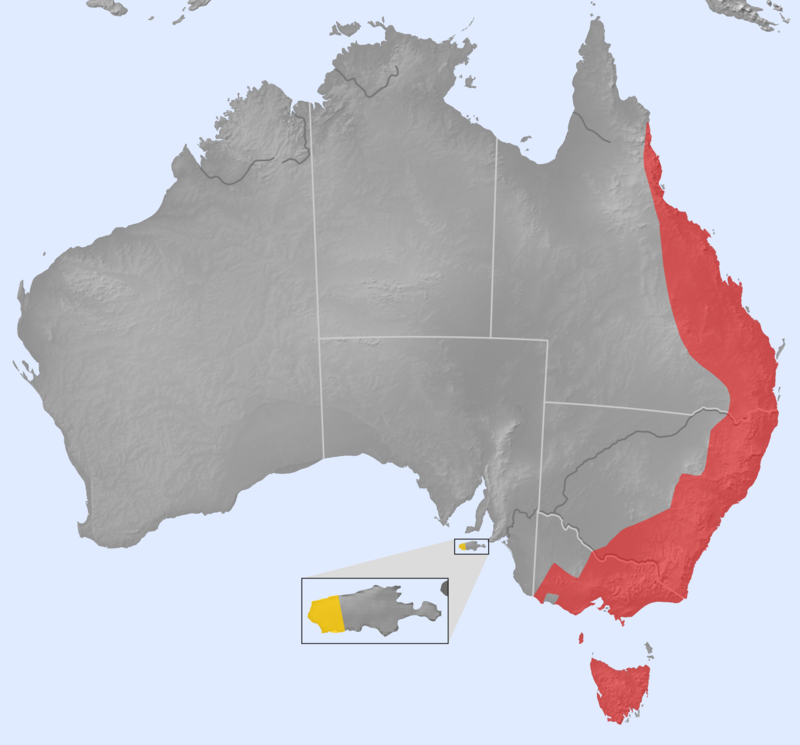
Platypus range
(red – native, yellow – introduced


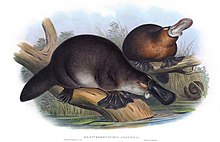




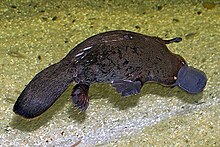

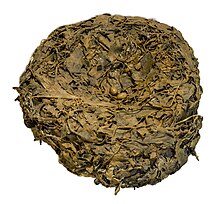







No comments:
Post a Comment
Note: Only a member of this blog may post a comment.